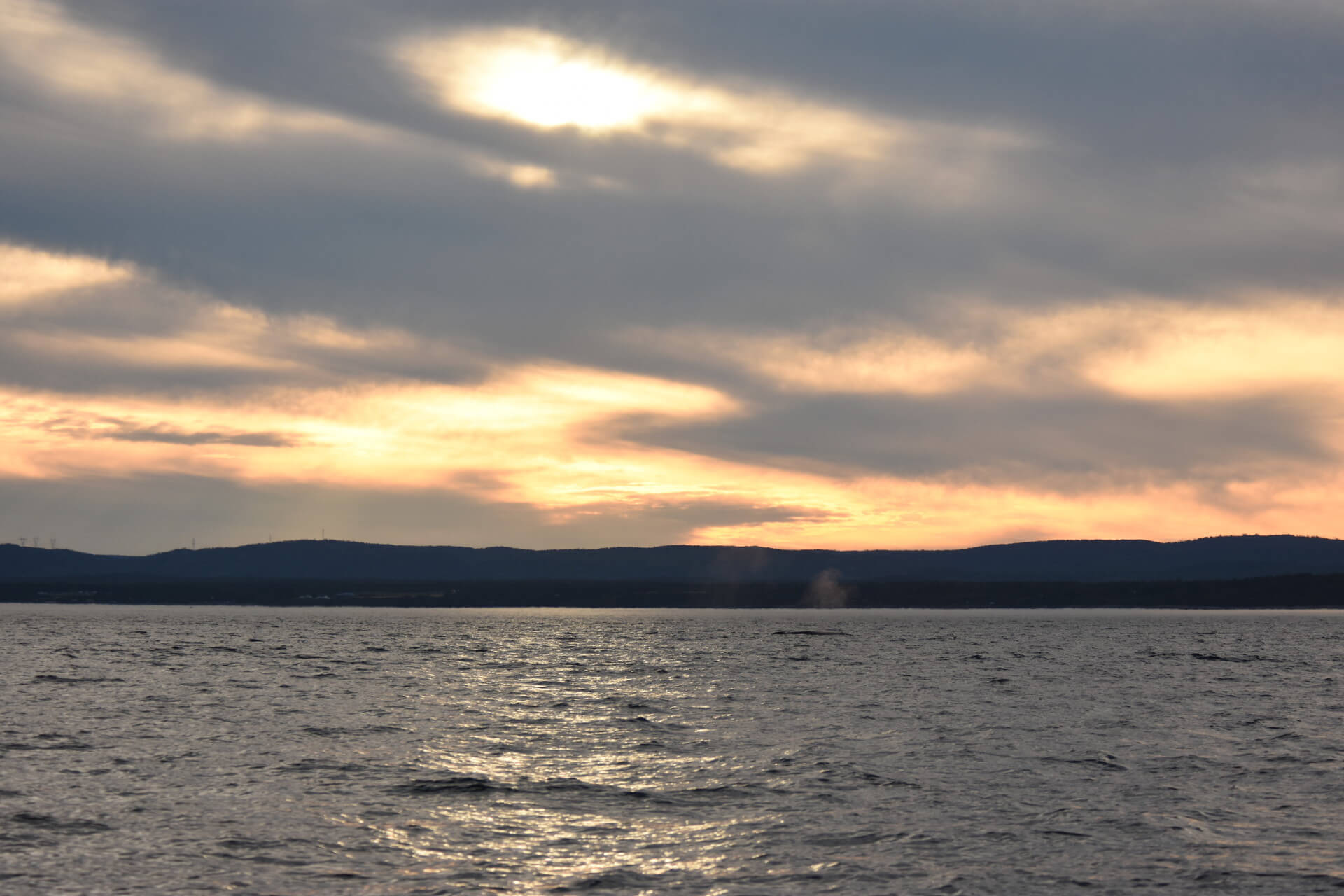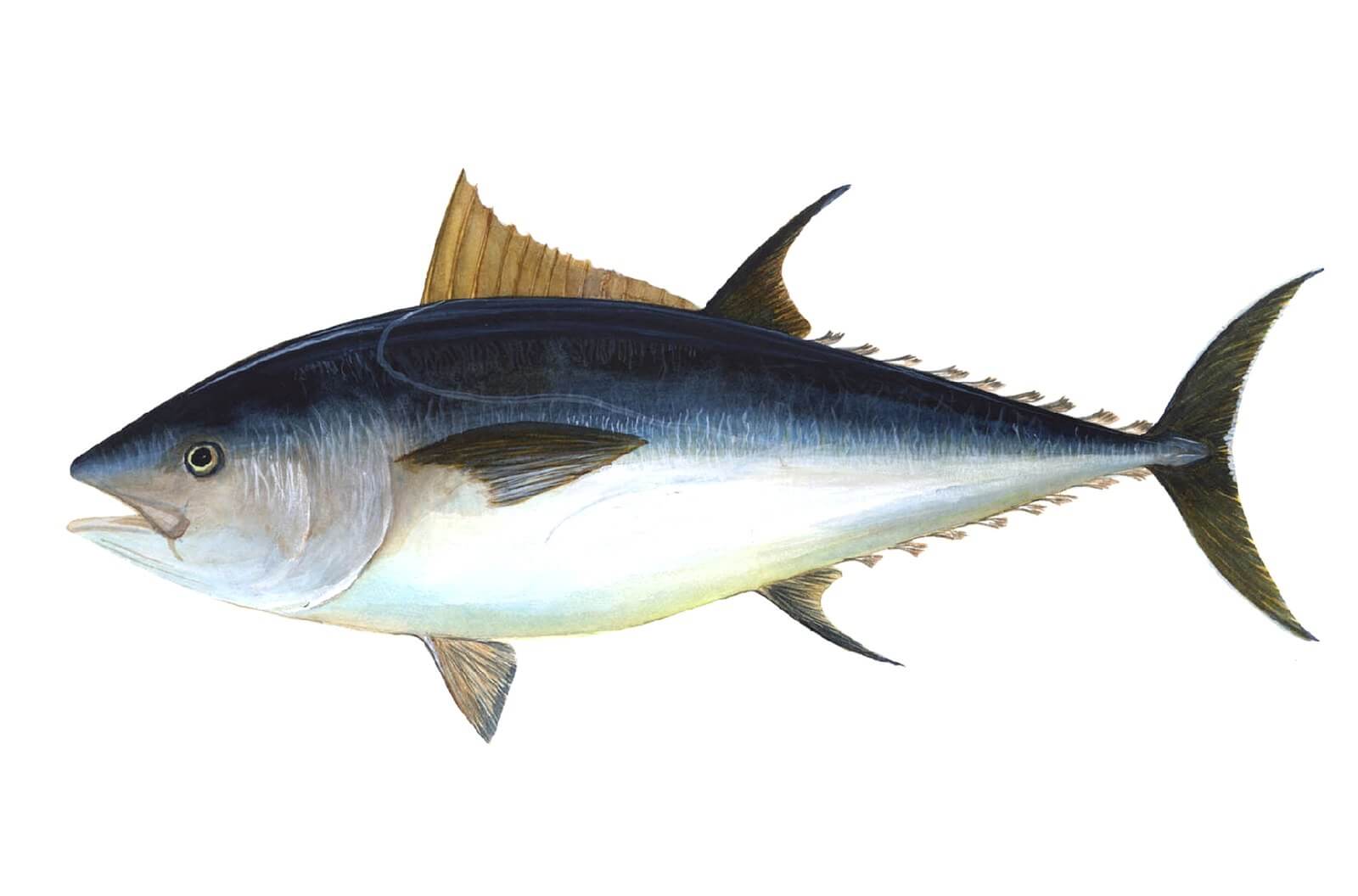It is a beautiful evening of observation, a magnificent sunset, a refreshing breeze, a most grandiose panorama. The eyes turned towards the open sea, it is possible to see marine mammals coming to breathe at the surface. The evening progresses, and the observations accumulate, when suddenly, a large marine animal jumps out of the water. Its color varies from black to light grey and it seems to have several fins… it does not look like a dolphin or a porpoise. Which animal is it?
The culprit could be a fish: the Atlantic bluefin tuna. It is a fish that can be observed from the surface! This week, it was seen in Gaspé Bay, in the St. Lawrence Estuary and in Grande-Rivière. It preys on schools of small pelagic fish that it pushes towards the surface. It is at this moment that it can jump out of the water, which intrigues many observers!
It is recognizable by its conical head, the presence of 2 dorsal fins and small pectoral and pelvic fins. To distinguish it from marine mammals, it is also interesting to notice the movement from left to right of the tail, while cetaceans undulate the tail from top to bottom. While juveniles are opportunistic feeders, adults feed on fish.
This large fish can measure up to 3 meters and weigh over half a ton. The Committee on the Status of Endangered Wildlife in Canada (COSEWIC) has listed the Atlantic bluefin tuna as an endangered species in 2011.
Breaths in the fog
When a large blow is seen offshore, it is certain that it is a cetacean! In Gaspé Bay, between 7 and 8 humpback whales delight visitors, not to mention the two fin whales, minke whales and harbour porpoises in abundance, while blue whales are still to be seen. They have not yet been observed since the beginning of the season in the area.
On the North Shore, in Franquelin, minke whales, harbour porpoises and grey seals were observed. However, other species caught the attention of observers. Through the fog, a sound breath is heard, probably a large whale. “Two pods of dolphins were moving at high speed, said an enthusiastic observer. It was beautiful, it made a big swirl in the water. They seemed to be heading towards Baie-Comeau, but they probably continued towards the estuary. ”
At Pointe-des-Monts, Friday August 26 was a great day of observation for marine mammals’ enthusiasts, who had the chance to cross paths with several humpback whales, including a mother-calf pair and several adults.
At the Mingan Island Cetacean Research Station (MICS), the presence of fog reduces the possibilities of observation. However, the team was able to spot 4 fin whales, 3-4 minke whales, between 20 and 25 white-sided dolphins as well as hundreds, if not thousands, of harbour porpoises.
Near Havre-Saint-Pierre, boaters have the chance to see humpback whales. “All of a sudden, I hear a blow in the distance. It’s certain, it’s that of a large whale. I can’t see where it’s coming from. We hear it again and we see a blow and a whale jump out of the water. Finally, I see them with binoculars. There are two of them: one makes another jump, the other hits the water with its pectoral fin. Wow! Then they dive one after the other, raising their tails.” The presence of orcas also allows a few lucky observers to capture some great shots.
Going eastward, in Essipit, an observer had the opportunity to admire groups of belugas. She also saw humpback whales for the first time: “They were very numerous. They were diving and showing their tails. It turned me upside down for hours, it was so beautiful. I was on the rock, on the shore, and you could hear the blows very well. It was an enchantment.
Humpback whales in the fjord
Humpback whales seem to have made a habit of coming up the Saguenay Fjord this season. A shoreline resident who is passionate about marine mammals and who works for the GREMM explains his observation in amazement. “Last week I was lucky enough to see, not even three minutes after waking up, a large blow in the middle of a sea of oil in front of our little cottage in L’Anse-de-Roche. I was used to seeing belugas going up and down the Saguenay River, so I was really surprised to realize that a big whale was right in front of my house. […] After a few hours in the boat following this little humpback, it was identified as H919.” This individual has been observed in the St. Lawrence Estuary since 2018.
The humpback whale H858, alias Queen, was also observed in the fjord last week. Photographer and naturalist Renaud Pintiaux says: “Wonderful caudal fin. Wonderful white border on the trailing edge of the external caudal. We spotted it this morning near Pointe Rouge in Tadoussac. He then made an appearance… in the bay of Tadoussac before entering the Saguenay Fjord and staying for most of the day!” The photographer also had the chance to observe “a few beluga whales, a large herd of grey seals and a minke whale under the sun.” The humpback whale H858, alias Queen, can be distinguished by its predominantly white caudal fin with a black line on the right lobe.
Weekly sighting map
These data were reported by our network of observers. The observations give a rough idea of the presence of whales, but do not in any way represent the true distribution of cetaceans in the St. Lawrence. Enjoy!
Click on the whale or seal icons to see the species, number of individuals observed, additional information or photos of the sighting. To zoom in on the map, click on the icon in the upper right corner. The map works well on Chrome and Firefox, but less so on Safari.
To display the list of observations, click on the icon in the upper left corner.
Vous souhaitez partager vos observations et contribuer à la science citoyenne ? Utilisez l’outil de saisie d’observation de mammifères marins.













